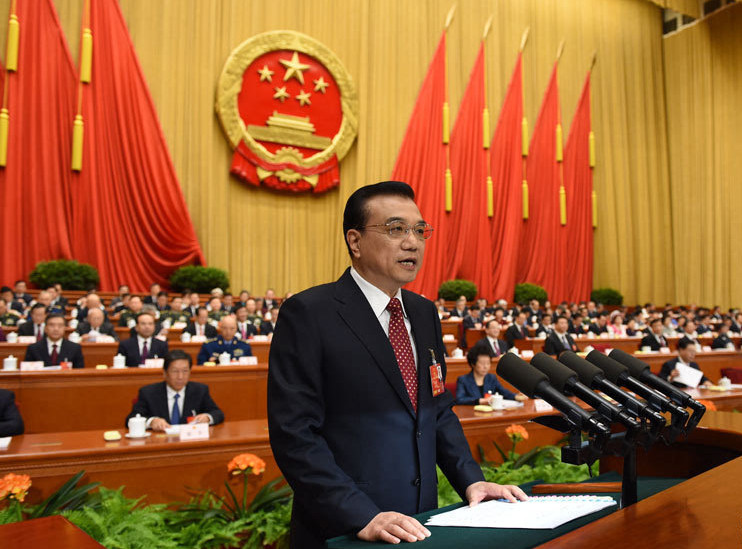Scholars: Work report lays solid basis to reach 2020 goals

Chinese Premier Li Keqiang delivers the government work report at the fourth session of the 12th National People's Congress.
Chinese scholars praised the government work report Premier Li Keqiang delivered at the recently concluded National People’s Congress (NPC), noting that it offers guidance for industrial restructuring and steady growth under the 13th Five-Year Plan.
“The goals and tasks for the 13th Five-Year Plan center on the five new closely related development concepts, including innovation, coordination, greenness, openness and sharing,” said Zhang Xiaoshan, an NPC deputy and CASS Member of the Chinese Academy of Social Sciences (CASS).
Placing emphasis on reform and development, the work report was released at the annual meeting of the nation’s highest legislative body, which concluded on March 16. The report identifies concerns at home and abroad while focusing on the public interest and demonstrating the government’s resolve to address various problems, scholars said.
Marking the beginning of the 13th Five-Year Plan, 2016 is a crucial year for attaining the goal of building a moderately prosperous society by 2020, Chinese scholars said. A significant portion of the report is devoted to highlighting the goals and key tasks for the next five years.
The five development concepts are a result of reflections on the past development path. The goals and tasks are not only guidelines but also concrete measures. As long as we actualize them, the Chinese economy can definitely achieve new heights, Zhang Xiaoshan said.
According to the report, the target for GDP growth is a range from 6.5 percent to 7 percent. This is the first time the Chinese government has used a range for planned GDP growth.
Yu Yongding, a member of the Chinese People’s Political Consultative Conference (CPPCC) and CASS Member, said that the growth rate over the next five years must reach 6.52 percent or higher if policymakers hope to realize the goal of doubling per capita incomes of urban and rural citizens relative to 2010 levels by 2020.
Moreover, the decline of growth since 2012 suggests that it is indeed impossible for the potential growth rate to reach 8 percent or higher. Now that China’s economy has entered the “new normal,” the real potential growth rate has fallen to within a range of approximately from 6.5 percent to 7 percent, Yu said.
“In order to hold the bottom line of growth, the report struck a good balance between short-term macroeconomic control and long-term supply-side reform, which is quite commendable,” Yu said.
Yu said short-term macroeconomic control is necessary to increase fiscal deficits and stimulate effective demand, thereby buying time for supply-side reform. In the long term, supply-side reform is critical for speeding up potential growth.
The report emphasized beefing up supply-side structural reform to strengthen the momentum of sustainable development. It also specified some measures for unleashing the potential of business startups and innovation throughout society, which will soak up excess capacity and intensify the reform of State-owned enterprises.
For example, central finance organs have allocated 100 billion yuan of special rewards, subsidies and funds for the resettlement of employees. A punitive damages system for inferior commodities has been established while craftsmanship and innovation are being promoted among entrepreneurs. Also, the “Made in China” and “Internet Plus” strategies promise new sources of growth.
Yu said measures for supply-side reform are the prerequisites for raising labor and total factor productivity and increasing the efficiency of capital utilization, which will ultimately create a sustainable economy. Furthermore demand management cannot be overlooked, because it is vital to keep the economy running within a reasonable range, he added.
Premier Li also said, “Despite a slowdown in the growth of fiscal revenues, we cannot slack off in doing good for the masses.” Zhang Zhao’an, an NPC representative and deputy director of the Institute of Economics at the Shanghai Academy of Social Sciences, said the government’s attention to the public’s standard of living fully embodies its people-oriented governance style.
The annual financial subsidy for basic medical insurance of urban and rural residents has been increased from 380 yuan to 420 yuan per capita. More general medical practitioners and pediatricians will be cultivated. In 2016, a goal has been set to lift 10 million rural people out of poverty. A number of cities will install optical networks, and Internet access will be extended to 50,000 administrative villages to help more urban and rural residents overcome the digital divide. All these policies are reflective of the government’s resolve to benefit the people.
Zhang Xiaoshan said that these policies should be carried out step by step to bring real benefits to the people and instill into them confidence in the next five years.
Huo Wenqi is a reporter at the Chinese Social Sciences Today.
